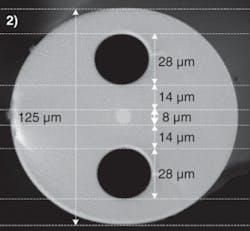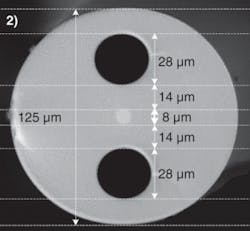Fiber Bragg gratings switch in nanoseconds
High-speed switching or tuning of light in fiber Bragg gratings (FBGs) can be applied to Q-switching, cavity dumping, and pulse picking in a fiber laser, among other applications. Although many options have been used such as bending beams, stretching light with a piezoelectric stack, and using magnetic fields, these techniques are relatively slow (microsecond tuning speeds) and have mechanical durability issues. But researchers at the Joint Research Centre of Photonics of the Royal Institute of Technology (Sweden) and Zhejiang University (Hangzhou, China), and Acreo collaborating within Kista Photonics Research Center (Kista, Sweden), are using electrodes placed within microstructured fibers to cause high-speed electro-optical switching and modulation.
High-voltage electrical pulses are applied to the electrodes-formed by pumping metal alloys in the holes of a two-hole fiber-which in turn heat up, expand, and induce birefringence changes in the FBG written in the core of the fiber. This birefringence causes two reflection peaks at different wavelengths corresponding to the different effective refractive indices for the two orthogonal polarization modes in the fiber, allowing the gratings to be tuned with a response time of only 29 ns. Contact Walter Margulis at [email protected].

